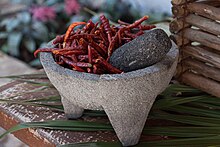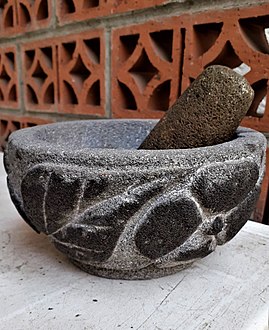Molcajete
This article needs additional citations for verification. (July 2015) |


A molcajete (Spanish: [molkaˈxete]; Mexican Spanish, from Nahuatl molcaxitl) and tejolote (from Nahuatl texolotl) are stone tools, the traditional Mexican version of the mortar and pestle,[1][2] similar to the South American batan, used for grinding various food products.
Description

The molcajete was used by pre-Hispanic
In the pre-Hispanic Mesoamerican period, the molcajete had a lid and the set was believed to be used for burial of members in society of high status. Additionally, throughout the pre-Hispanic Mesoamerican period, they were decorated with various colors and designs, and orange wares were identified as the most common characteristic of the molcajete.[3] The matching hand-held grinding tool, known as a tejolote (Mexican Spanish, from Nahuatl texolotl), is made of the same basalt material.
Use and care


Molcajetes are used to crush and grind
A new basalt molcajete needs to be "broken in" because small grains of basalt can be loosened from the surface when it is first used and this will give an unpleasant gritty texture to the first few items prepared in it. A simple way to do the initial "seasoning" is to grind uncooked white rice in the molcajete, a handful at a time. When the white rice flour has no visible grains of basalt in it, the molcajete is ready to use. Some rice flour may remain ground into the surface of the molcajete, but this causes no problems.
As the porous basalt is impossible to fully clean and
Molcajetes are also used as dish service in restaurants and homes. While recipes are usually not stewed or otherwise cooked in them, the molcajete stays hot for a very long time due to its high thermal mass, and it is not unusual for a dish to still be bubbling half an hour after serving.
Gallery
- Examples of molcajetes
-
Old molcajete, probably pre-Hispanic made in a stone in situ, municipality of San Miguel Achiutla, Oaxaca, Mexico
-
Grinding in a molcajete. San Juan Achiutla, Oaxaca, México.
-
"Salsa de molcajete". San Juan Achiutla, Oaxaca, México.
-
Molcáxitl with flower petal decoration, originating from San Salvador el Seco, Puebla, México
-
Well used tripod molcajete, origin unknown
-
Tripod molcajete with a pig's head decoration, originating from San Salvador el Seco, Puebla, México; a very popular model in the taquerías (taco shops) of México City
See also
![]() The dictionary definition of Molcajete at Wiktionary
The dictionary definition of Molcajete at Wiktionary
- Batan
- Metate
- Mortar and pestle
- Oralu kallu
- Suribachi
References
- ^ Mc Kelvey, Anita (18 October 2011). "The Original Chile Grinder". The Philadelphia Pepper Project. Retrieved 20 September 2018.
- ISBN 978-0740769764.
- ^ Moser, Chris L. "Matching Polychrome Sets from Acatlan, Puebla." American Antiquity 34, no. 4 (1969): 480-83. doi:10.2307/277749.
Bibliography
- Adams, Richard E.W. (2005). Prehistoric Mesoamerica (3rd ed.). Norman: OCLC 58975830.
- Coe, Sophie D. (1994). America's First Cuisines (4th pbk printing [2002], 1st ed.). Austin: OCLC 0292711557.
- Simmons, Marie (2008). Things Cooks Love: Implements, Ingredients, Recipes. Missouri: Andrews McMeel Publishing. ISBN 978-0740769764.







